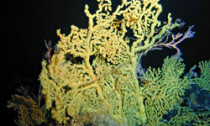
In addition to providing shelter and being an important part of a marine ecosystem, coral reefs can also serve as a record of long-term changes to the ecosystem. According to a new study published on Sunday in the journal Nature, an analysis of Pacific corals has revealed changes at the bottom of the marine food web observed in recent decades in the North Pacific Subtropical Gyre may have started over 150 years ago.
The study team reached their conclusion by analyzing a hard protein material in coral exoskeletons that incorporates chemical signatures from the corals phytoplankton food sources.
“They’re like living sediment traps, recording long-term changes in the open ocean that we can’t see any other way,” said study author Matthew McCarthy, professor of ocean sciences at University of California, Santa Cruz.
While sediment cores from the ocean floor can provide clues to past conditions, they are not useful for getting more recent information. In the North Pacific, where the study was conducted, marine sediment builds up so gradually that the past 12,000 years is represented by less than 4 inches of sediment that is constantly being stirred up.
“Even if there were good sediment records, we would never get the level of detail we can get from the corals,” McCarthy said.
In their their analysis, the study team used carbon dating and a novel technique for determining nitrogen isotopes in proteins. The scientists were able to reconstruct events from the past 1,000 years, which showed a drop in nutrients of surface waters of the open ocean that started around 1850. As a result, the phytoplankton community at the foundation of the Pacific food web became increasingly dominated by nitrogen-fixing cyanobacteria, which can utilize the nitrogen gas absorbed by surface waters from the surrounding air.
“In the marine environment, the two major sources of nitrogen are dissolved nitrate, which is more concentrated in the subsurface and deep water and is brought to the surface by upwelling, and nitrogen fixation by specialized microorganisms that are like the legumes of the sea,” explained study author Owen Sherwood, a researcher at the University of Colorado, Boulder.
The study team found a 17 to 27 percent increase in nitrogen-fixation since about 1850, after nearly 1,000 years of comparatively minor fluctuations.
“In comparison to other transitions in the paleoceanographic record, it’s gigantic,” Sherwood said. “It’s comparable to the change observed at the transition between the Pleistocene and Holocene Epochs, except that it happens an order of magnitude faster.”
The researchers said their results along with those of other recent studies are changing scientists’ ideas about the steadiness of open ocean gyres, which were once considered fairly inert, nutrient-deprived ‘deserts’. Starting in the 1980s, researchers began regularly tracking oceanographic conditions near Hawaii, revealing a considerable amount of variability.
“Instead of relatively constant ocean deserts, time-series data has shown dynamic decadal-scale changes,” McCarthy said. “Our new records from deep-sea corals now show that the decadal-scale changes are really only small oscillations superimposed on a dramatic long-term shift at the base of the Pacific ecosystem. This long-term perspective may help us better predict the effects of global warming on open ocean regions.”
Source











Social Profiles